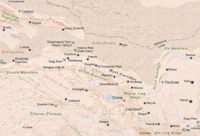
Photo from wikipedia
OBJECTIVES The Tibetan-Yi Corridor located on the eastern edge of Tibetan Plateau is suggested to be the key region for the origin and diversification of Tibeto-Burman speaking populations and the… Click to show full abstract
OBJECTIVES The Tibetan-Yi Corridor located on the eastern edge of Tibetan Plateau is suggested to be the key region for the origin and diversification of Tibeto-Burman speaking populations and the main route of the peopling of the Plateau. However, the genetic history of the populations in the Corridor is far from clear due to limited sampling in the northern part of the Corridor. MATERIALS AND METHODS We collected blood samples from 10 Tibetan and 10 Han Chinese individuals from Gansu province and genotyped about 600,000 genome-wide single nucleotide polymorphisms (SNPs). RESULTS Our data revealed that the populations in the Corridor are all admixed on a genetic cline of deriving ancestry from Tibetans on the Plateau and surrounding lowland East Asians. The Tibetan and Han Chinese groups in the north of the Plateau show significant evidence of low-level West Eurasian admixture that could be probably traced back to 600∼900 years ago. DISCUSSION We conclude that there have been huge population migrations from surrounding lowland onto the Tibetan Plateau via the Tibetan-Yi Corridor since the initial formation of Tibetans probably in Neolithic Time, which leads to the current genetic structure of Tibeto-Burman speaking populations.
Journal Title: American journal of physical anthropology
Year Published: 2017
Link to full text (if available)
Share on Social Media: Sign Up to like & get
recommendations!